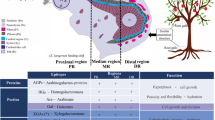Abstract
In the search for biochemical and molecular markers of juvenility in trees proteins have been identified which are preferentially or differentially expressed in either the juvenile or the mature phases of Prunus avium cv. Stella. These fall into two classes: those which are phase-related and those which may be affected by root-shoot distance. N-terminal amino acid sequence data from some of these proteins were used to produce polyclonal antibodies to corresponding synthetic peptides in order to determine if they could be used as markers of phase state in woody plants. Western blot analysis was performed on proteins extracted from three sources; juvenile trees, mature trees and rooted cuttings from mature trees. The results showed that the antibodies recognised differentially-expressed proteins. In particular, one antibody to a juvenile specific protein cross-reacted with a polypeptide of approx. 28 kDa which was present in greater amounts in shoot tips of juvenile P. avium cv. Stella seedlings compared with rooted cuttings of mature plants placed in the same growth environment.
Similar content being viewed by others
References
Amo-Marco JB, Vidal N, Vieitez AM and Ballester A (1993) Polypeptide markers differentiating juvenile and adult tissues in chestnut. J. Plant Physiol. 142: 117–119
Arumuganathan K and Earle ED (1991) Nuclear DNA content of some important plant species. Plant Mol. Biol. Rep. 9: 208–218
Besford RT (1990) The greenhouse effect: acclimation of tomato plants growing in high CO2, relative changes in Calvin cycle enzymes. J. Plant Physiol. 136: 458–463
Besford RT, Hand P, Peppitt SD, Richardson CM and Thomas B (1996) Phase change in Prunus avium: differences between juvenile and mature shoots identified by 2-dimensional protein separation and in vitro translation of mRNA. J. Plant Physiol. 147: 534–538
Besford RT, Hand P, Richardson CM and Peppitt SD (1966) Photoperiod effect on bud burst in Prunus is phase dependent-significance for early photosynthetic development. Tree Physiol. 16: 491–496
Besford RT, Thomas B, Huskisson NS and Butcher GW (1990) Characterisation of conformers of D1 of Photosystem II using site-directed antibodies. Z. Naturforsch. 45C: 621–626
Bon MC (1988) J16: an apex protein associated with juvenility of Sequoiadendron giganteum. Tree Physiol. 4: 381–387
Bon MC, Riccardi F and Monteuuis O (1994) Influence of phase change within a 90-year-old Sequoia sempervirens on its in vitro organogenic capacity and protein patterns. Trees 8: 283–287
Bradford MM (1976) A rapid and sensitive method for the quantitation of microgram quantities of protein utilizing the principle of protein-dye binding. Anal. Biochem. 72: 248–254
Brink RA (1962) Phase change in higher plants and somatic cell heredity. Q. Rev. Biol. 37: 1–22
Catty D (1988) Properties of antibodies and antigens. In: Catty D (ed) Antibodies-A Practical Approach, Volume 1, pp 7–18. Oxford: IRL Press
Hackett WP (1985) Juvenility, maturation, and rejuvenation in woody plants. Hort. Reviews 7: 109–155
Huang L-C, Lius S, Huang B-L, Murashige T, Mahdi EFM and VanGundy R (1992) Rejuvenation of Sequoia sempervirens by repeated grafting of shoot tips onto juvenile rootstocks in vitro. Model for phase reversal of trees. Plant Physiol. 98: 166–173
Huang L-C, Lin L-Y, Chen C-M, Chen L-J, Huang B-L and Murashige T (1995) Phase reversal in Sequoia sempervirens in relation to mtDNA. Phys. Plant. 94: 379–383
Hunkapillar MW, Hewick RE, Dreyer WJ and Hood LE (1983) High sensitivity sequencing with a gas phase sequenator. Methods Enzymol. 91: 399–413
Murray JR, Smith AG and Hackett WP (1994) Differential dihydroflavonol reductase transcription and anthocyanin pigmentation in the juvenile and mature phases of Ivy (Hedera helix L.) Planta 194: 102–109
Poethig RS (1990) Phase change and the regulation of shoot morphogenesis in plants. Science 250: 923–930
Snowball AM, Zeman AM, Tchan YT, Mullins MG and Goodwin PB (1991) Phase change in Citrus: immunologically detectable differences between juvenile and mature plants. Aust. J. Plant Physiol. 18: 385–396
Takabe T, Takabe T and Akazawa T (1986) Biosynthesis of P700-chlorophyll a protein complex, plastocyanin, and cytochrome b 6 /f complex. Plant Physiol. 81: 60–66
Author information
Authors and Affiliations
Rights and permissions
About this article
Cite this article
Hand, P., Besford, R.T., Richardson, C.M. et al. Antibodies to phase related proteins in juvenile and mature Prunus avium . Plant Growth Regul 20, 25–29 (1996). https://doi.org/10.1007/BF00024053
Issue Date:
DOI: https://doi.org/10.1007/BF00024053




